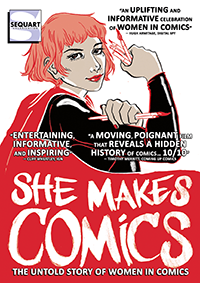 Dr. Deborah Elizabeth Whaley is an Associate Professor of American Studies and African American Studies at the University of Iowa. A scholar of race, gender, and popular culture (as well as other fields), Dr. Whaley has made a career of critically analyzing how mass media reflects and shapes culture. Her latest book, Black Women in Sequence: Re-Inking Comics, Graphic Novels, and Anime examines how African, African American, and multi-ethnic women are represented in sequential art, including graphic novels, comics, video games, and animation, and how they influence the production of these mediums.
Dr. Deborah Elizabeth Whaley is an Associate Professor of American Studies and African American Studies at the University of Iowa. A scholar of race, gender, and popular culture (as well as other fields), Dr. Whaley has made a career of critically analyzing how mass media reflects and shapes culture. Her latest book, Black Women in Sequence: Re-Inking Comics, Graphic Novels, and Anime examines how African, African American, and multi-ethnic women are represented in sequential art, including graphic novels, comics, video games, and animation, and how they influence the production of these mediums.
Sequart’s Nicholas Yanes interviewed Dr. Whaley about Black Women in Sequence and the issue of diversity in media. (You can pick up your own copy of Black Women in Sequence here and you can follow her on twitter @dewhaley.)
Nicholas Yanes: What was the inspiration for writing Black Women in Sequence? Specifically, why were you attracted to this project?
Dr. Deborah Whaley: In 2004, I saw the film Catwoman starring Halle Berry, and although the film was not great, I thought it would be interesting to write about it for a few reasons. One, I always felt an affinity to the comic book and graphic novel character, as well as the portrayal of Catwoman on the television show Batman. I also grew up reading comics and watching shows like Wonder Woman and I connected to the strong female characters in Batman the television show and Wonder Woman. I thought it might make a good article to look at the representation of Catwoman over the years in the various forms of multimedia in which she appears and to make nods to other female comic book characters.
I am also an artist, but the only formal training I have done in art is in cartooning. So I began to think that writing the article on Catwoman was a great opportunity to research something that I have an affinity to and experience with as a writer, artist, and fan. Once I began to research women in comics, I realized that there was almost nothing written about Black women in comics as producers, readers, and characters. I then decided that I would reach beyond writing the article on Catwoman and I began to research and write what ended up being Black Women in Sequence.
Yanes: With so much academic research on comics, how do you see this book standing out and contributing to this field?
Dr. Whaley: Many books on comics look only at print comics, few write about women characters, and even fewer write about race, ethnicity, and sexuality in comics. Most books on comics entail close readings of storylines, look at fandom, or contain interviews, but few do all of these things. Black Women in Sequence contains close interpretations of print and moving image media, but it also includes interviews with writers and artists, considers fandom and readers’ viewpoints. Further, it is a cultural history that considers the deployment of Black women sequential art characters in the US and abroad. I am the first scholar to publish a book on Black women in comics.
Yanes: On this note, there are a growing number of people examining women in the production of and in the narratives of comics, graphic novels, and anime. What more do you think could be done to make these genres more inclusive?
Dr. Whaley: Comic companies and other outlets need to continue to take risks on diverse characters and employ a diversity of writers and artists. You are right; things are a lot better now. Artists like Afua Richardson and Ashley Woods, whom I write about and interviewed for the book, have made great strides in independent and mainstream comics. Characters like Vixen and Storm have their own graphic titles and appear in film or animation. Comic’s editor Joseph P. Illidge has written thoughtfully about increasing diversity in the field, including issues related to production and character development. Our work in this area is two-fold: the field needs to diversify and consumers need to support indie comics and mainstream comics that represent a broader spectrum of narratives and characters that incorporate ethnicity, gender, sexuality, and disability in fresh and complex ways.
Yanes: Black Women in Sequence has information that is almost impossible to find elsewhere. How did you go about gathering your archive for this project?
Dr. Whaley: I tried to read every comic book, comic strip, and graphic novel with Black female characters. This meant reaching back to the 1930s. I went through a lot of Black and mainstream newspapers from the 1930s to the 1990s and tried to find storylines in comic strips that addressed larger issues in culture, especially concerning politics, nation-making, gender, class, race, and sexuality.
I approached as many Black women writers and artists doing comics that I could find to conduct interviews. I worked to make connections between the print representations and representations in film, video games, and anime. I of course had to read as many secondary sources as possible, address all relevant historical contexts, and did research on the background of artists and writers and other things they were involved in like civil rights and the Communist Party. For one of the artists and writers I write about I had to obtain and then read her 250-page FBI file.
Yanes: On this note, what were some bits of information you came across that took you by surprise?
Dr. Whaley: In my reading of and participation in electronic message boards, I was surprised by the diversity of readers interested in Black female characters. Male, female, international, domestic, and multi-ethnic readers are all engaged in the Black female image in sequential art. I found a second community within Black nerd culture online, too, that I did not know existed before I began to write this book.
The most interesting thing I came across was the FBI file on the cartoonist Jackie Ormes, which led me to write a chapter about how Black artists and writers used comic strips to discuss political ideas in the 1930s, ’40s, and ’50s. My research uncovered how dangerous it was in these earlier decades to express even the most banal political ideas about race and nation making, which could lead to government surveillance.
Yanes: Your book examines contemporary comic books, graphic novels, film, manga, and video gaming. How do differing mediums change the way in which black women are represented? In other words, does one medium typically highlight a certain feature compared to other?
Dr. Whaley: A lot of times the films and television shows cannot address the nuance and history of the characters like the graphic novels or comic books can, and this is almost always disappointing to fans. As for video games, the interaction between the players and the characters is performative – players can actually embody or interact digitally with a character. Anime and manga is very different in terms of aesthetics, and a lot of US artists and writers are very influenced by Japanese popular culture, which is represented in their work.
Nearly every writer and artist I spoke with discussed their love for manga and anime. I also found that the Japanese production of African characters in anime is indicative of US history and popular culture. There is a lot of international or transnational exchange between writers, artists, animators, and fans in the US and abroad. The Internet, new and social media has, in part, made this exchange possible.
Yanes: This book also highlights black women who create content. In regards to black women creators, who are some of the unsung heroes that should be highlighted more in comics studies?
Dr. Whaley: All of the women I write about are unsung heroes: Leisl Adams, Michelle Billingsly, Barbara Brandon-Croft, Jennifer Crute, Rashida Jones, Rashida Lewis, Jackie Ormes, Afua Richardson, Juliana Smith, Viga Victoria, Nara Walker and Ashley Woods.
Yanes: With the rise of the #BlackLivesMatter and related movements, how do you think mainstream representation of black women will change as white Americans begin to truly acknowledge the existence of institutional racism?
Dr. Whaley: I do not know that this movement or any movement alone will change the mainstream representation of Black women. We have some diverse representations out there in media in general, but this does not seem to undo prejudicial ideas about Black women in the popular imagination or institutional racism.
A lot of times, diverse representations of Blackness and consumption of Black popular culture does not translate to or affect interaction with actual Black people. You can listen to John Coltrane and hate Black men. You can watch The Flash, Daredevil, and Gotham, all of which have Black female or Latina characters, and still not see, treat, or interact with Black women in fair and non-racist ways. For example, characters like Iris West on The Flash are great, but this representation alone will not fix institutional racism.
That does not mean that these characters cannot provide new ways of seeing and thinking for some, it just means that undoing prejudice is an ongoing and difficult struggle. Since the presence of people of African descent in the Americas and elsewhere, there have been social movements addressing our marginalization. Despite progress, we still have a long way to go in achieving social justice.
Yanes: When someone finishes reading Black Women in Sequence: Re-inking Comics, Graphic Novels, and Anime, what is the one thing you hope they leave with?
Dr. Whaley: I would like readers to come away with an understanding of how the representations of Black women in sequential art remark more broadly on history and society, gender, race, class, nation, and sexuality, and the work that producers and consumers perform to reimagine and reflect Black women’s experiences anew.
Yanes: With this book done, what are the next areas of research you want to pursue next?
Dr. Whaley: My book in progress is tentatively titled Feeling Her Fragmented Mind: Women, Race, and Dissociative Identities in Popular Culture. It is an examination of dissociative identities (formerly known as multiple personality disorder) as a narrative trope in popular literature, film, television, and memoir, with a particular focus on Latinas, White, Asian-American, and Black women. The book draws from disability and affect studies and combines the humanities and social sciences to explore the disparities in the medical industrial complex and the ways women craft or inhabit alter and multiple identities.




















































